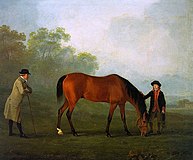Sawrey Gilpin

Sawrey Gilpin
Life and work
Gilpin was born in
As a child Gilpin learnt to draw from his father, who ran a drawing school in Carlisle. Having shown an early predilection for art, he was sent to London at the age of fourteen to study under the marine painter Samuel Scott in Covent Garden. Gilpin, however, preferred sketching the passing market carts and horses, and it soon became evident that animals, especially horses, were his speciality. Gilpin left Scott in 1758, and devoted himself to animal painting from then on. Some of his sketches were shown to the Duke of Cumberland, who was much impressed by them, and employed Gilpin to draw from his stud at Newmarket and at Windsor, where he was ranger of the Great Park. He afforded the artist considerable material assistance in his profession.[1]
Animal painter

Gilpin lived at
Gilpin first exhibited with the
He exhibited at the
Gilpin married Elizabeth Broom; their son
His pupils included John Warwick Smith and George Garrard. The latter married his eldest daughter Matilda.[2]
Works
Many of his pictures of horses, dogs, and sporting scenes were engraved, notably The Death of the Fox (Royal Academy, 1788), engraved by
There are works by Gilpin in the collections of the
.Gallery
-
Three Hunters in a Rocky Landscape
-
A painting of Pitch owned by Colonel Thomas Thornton, 1790
-
Gulliver Taking His Final Leave of the Land of the Houyhnhnms
-
Furiband with his Owner, Sir Harry Harpur, and a Groom (1774)
References
- ^ a b c d e f g h Stephen, Leslie, ed. (1890). . Dictionary of National Biography. Vol. 21. London: Smith, Elder & Co. pp. 382–3.
- ^ Biography of Sawrey Gilpin (Christies - 30 Aug 2010).
- ^ Portrait of Gilpin (by George Dance).
- ^ "Works by Sawrey Gilpin in Courtauld Institute collection".
- ^ "Tate Collection, works by Sawrey Gilpin".
- ^ "RA Collections, Sawrey Gilpin".
- ^ "Fitzwilliam Museum, works by Sawrey Gilpin". Archived from the original on 3 March 2016.
Further reading
- Cross, David A., Sawrey Gilpin R.A. : Rival of Stubbs, Armitt Library Journal, Ambleside, vol. 1 1998 pp. 64–85
- Gilbey, Sir Walter. Animal painters of England from the year 1650, volume 1 (London : Vinton & Co., 1900) p190 ff.




